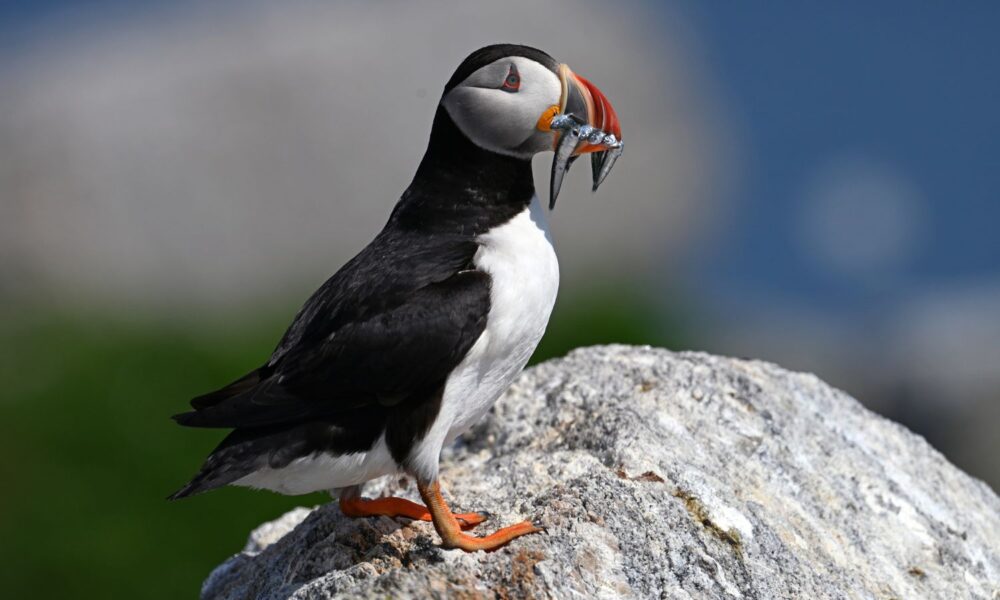Steve Kress’s smile lit up the dusk as research assistants at least 50 years younger than him regaled him with tales of their vigilance to save tern chicks on Stratton Island, Maine.
For an hour, all talk centered around a mortal enemy of tern chicks: the black-crowned night heron. The latter is a beautiful, stocky wetland bird with glowing red eyes and two delicate white plumes shooting out the back of its head. A nocturnal hunter, lucky photographers can catch it at dusk or dawn along rivers and ponds snapping fish out of the water in a split second.
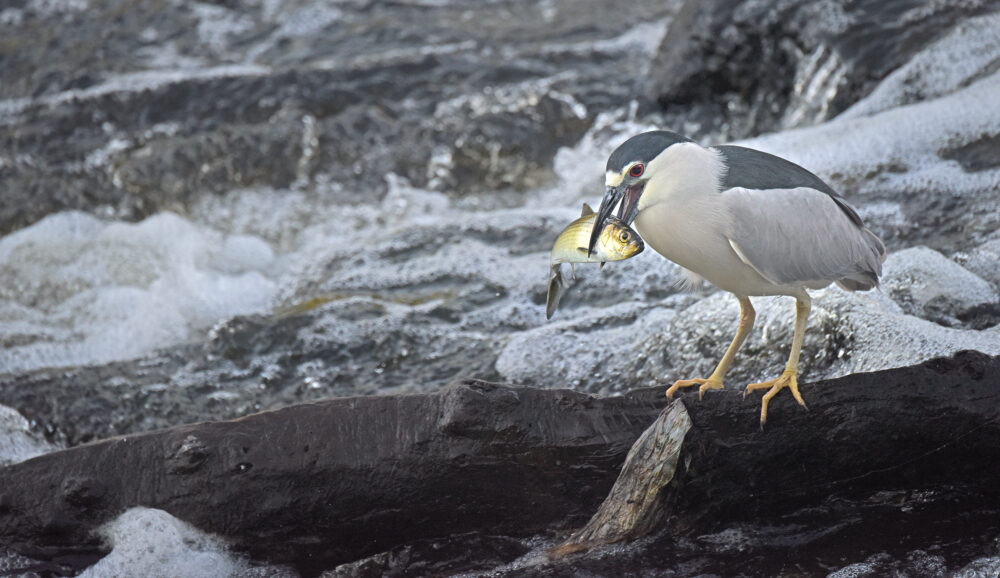
Stratton Island is three miles out to sea from Orchard Beach, Maine. The Audubon Seabird Institute, formerly known as Project Puffin, began restoring terns here in the 1980s. Kress founded the project in 1973.
On this island, in the dead of the night, the heron has other prey on the menu. It includes a precious colony of least terns, the smallest tern in the world, with a striking black cap and bright yellow bill. The tern was nearly wiped out on the East Coast in the late 19th century for hat feathers.
Despite their recovery from that slaughter —a recovery aided by the 1918 Migratory Bird Treaty—least terns are listed today as an endangered bird in Maine. It nests on sandy beaches, which often puts it in competition with human development and recreation. That fragility makes it critical to keep herons out of tern colonies as one heron can kill many chicks in hours. In 2022, just 14 chicks fledged out of 91 nests on Stratton. Last year, maybe four chicks survived to fledge off Stratton.
The team of Ben Becker, Kay Garlick-Ott, Tiffany Christian, Ellie Bretscher, Katelyn Shelton, and Joe Sweeney told Kress they are always “on edge” for the heron attacks and do everything possible to scare off herons. They use lights and lasers and make every kind of noise possible with bangers, screamers, and pot banging.
Kress chimed in that crews have also tried (in vain) to use a mannequin to startle the herons. There was one researcher years ago who dressed up as the action film character Rambo to hunt a heron that was terrorizing chicks. Another attempt to use lights to see herons resulted in federal authorities roaring out to Stratton in a boat, on a tip that it was a landing strip for drug runners.
Sadly, right after this visit, a heron evaded the crew and unleashed another lethal attack, reducing the number of least tern chicks from more than 60 to less than 20. The moment was symbolic of how Kress’s original vision for Project Puffin evolved dramatically over the years.
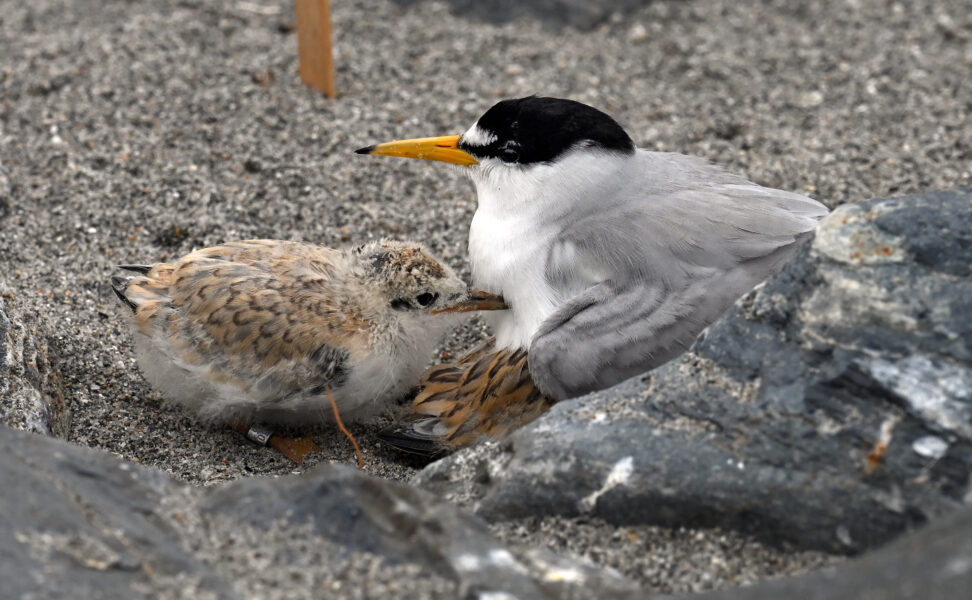
Protecting tern chicks from predators and other threats
All Kress had wanted to do a half-century ago was restore just one species, the Atlantic puffin, to Eastern Egg Rock, one small island off the coast of Maine. Puffins were hunted off nearly every island in Maine in the 1880s. Kress hoped that once he re-established the bird, with chicks translocated from Canada, it could maintain itself and that would be the end of the project.
He came to realize that breeding puffins and eventually other birds, such as terns, requires people to guard them for the entire 3 to 4 months of their breeding season. Whatever the ecosystem was centuries ago that allowed puffins and terns to thrive in Maine, now there are just too many threats. Some threats are other birds that thrive thanks to major conservation victories. For example, herring gulls, which also were slaughtered for hat feathers, recovered with the 1918 treaty. Bald eagles and peregrine falcons are flourishing again after the 1972 banning of the pesticide DDT. Other threats are tied to human sloppiness: Gulls went beyond recovery to crowding out other birds on Maine islands, boosted by banquets of coastal landfills and fishing waste.
It may all be part of a larger struggle of birds competing for dwindling habitat in the face of development, climate change, pesticides, industrial agriculture, and pollution. A 2019 study in the journal Science found that North America has lost more than a quarter of its bird population since 1970; there are nearly 3 billion birds less than there used to be.
“I had no idea we would face this complexity of the ongoing need for management,” Kress said. “It’s a myth that islands are separate from everything else. We can’t walk away from [the restorations], or they would eventually unravel.”
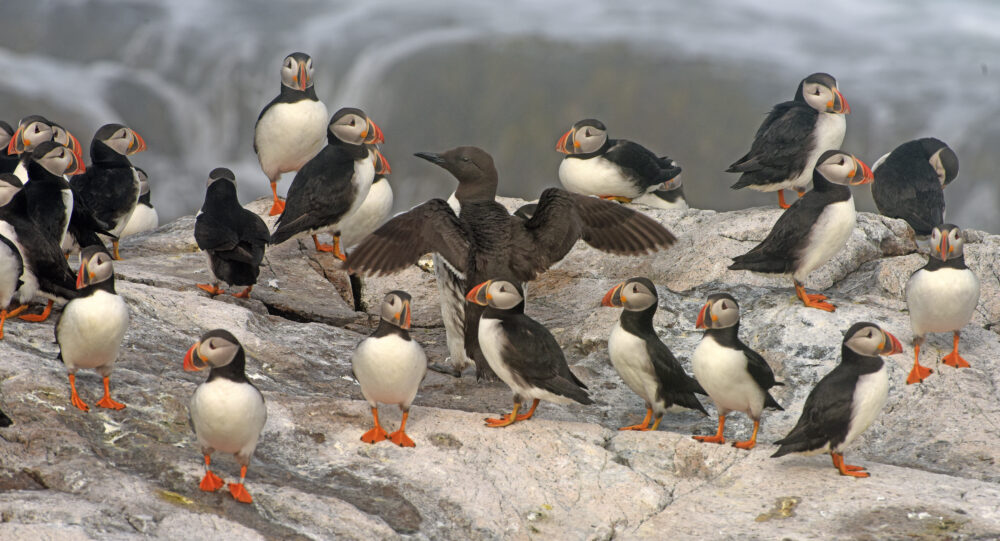
Passing on the torch at Project Puffin
They have not unraveled. The project has had at least 700 research assistants. At 28 years old, Becker, Garlick-Ott, and Christian are the same age that Kress (now 78) and his colleagues were when they started Project Puffin 51 years ago. The half-century age gap punctuates the success of Kress effectively sharing his vision with young researchers and entrusting them to carry out the mission. (That is exceedingly elusive in other spheres. For example, a 2008 Harvard Business School paper estimated that 4 of every 5 founders or co-founders are eventually forced out as CEOs. The long list includes founders or co-founders of Apple, JetBlue, Tesla, Zipcar, Twitter, Uber, PayPal, OpenAI, and Yahoo!.)
As Kress’s co-author and photographer on two books about Project Puffin, this aspect, the passing on of the founder’s torch, has enthralled me as much as the birds. Garlick-Ott, a former island supervisor who studies tern aggression on Stratton for her doctorate at the University of California Davis, said, “You get a quick sense that the torch is constantly being passed. It’s empowering and humbling at the same time. I feel like I have a purpose and a place in this project. When I became a supervisor, I wanted so badly to do what my supervisor did. I really wanted to be like her.”
Keenan Yakola, 31, is in his 11th summer with Project Puffin and the Seabird Institute. A former island supervisor and now a doctoral student at Oregon State University, he leads the GPS tagging of puffins, terns, and storm petrels to study where they feed. The Gulf of Maine is one of the fastest warming seas on Earth. He hopes the tracking will indicate how seabirds adapt to ocean heatwaves and help offshore wind developers site facilities to avoid conflict with birds.
Yakola said he learned early on that Project Puffin patiently welcomed innovation by college-age assistants. Perhaps that was because Kress himself almost did not get the chance to restore puffins. At first, a top Canadian official balked at the idea that Newfoundland puffin chicks would return to Maine as adults. Even after getting permission, it took eight years until Kress, then an Audubon camp bird instructor, reestablished puffin breeding on Eastern Egg Rock. His first artificial burrows for chicks were too hot or they flooded. The puffin chicks he raised in 1973 and 1974 disappeared into the Atlantic, never to be seen again.
“My first summer on the project, I didn’t feel I had a particular contribution to make other than to be a good intern and collect data,” Yakola said. “I just thought it was cool being with birds. But when I asked about analyzing diet data for my undergraduate thesis [at the University of Massachusetts Amherst], Paula [Shannon, the institute’s seabird sanctuary manager)] simply said, ‘Yeah, sure. Just ask Steve.’”
Shannon, 48, a former island supervisor who first began working with the project in 2002 and co-authored a 2016 paper with Kress showing how puffin diet was changing with the warming Gulf of Maine, seconded Yakola. She talked about how crews kept repositioning common murre decoys on Matinicus Rock until the first egg in more than a century was laid on that island in 2009. A cousin of the puffin, common murres, were also hunted in the 1800s until there were no breeding pairs left in Maine. Last year, a dozen murre chicks fledged off Matinicus Rock.
Kress once asked Shannon and others a question about an extinct bird.
“What would you do if a Great Auk showed up with the puffins?” he said.
She laughed and replied to him, “We’d probably take a picture and send the bird on its way because no one would believe us.” The question was both in jest and a suggestion that trying new things can have unforeseen victories in science.
The Great Auk indeed will never come back, but Kress’s restoration of puffins and murre have helped conservationists all over the world bring back seabirds from the brink of extinction. One or more of the methods used by Project Puffin, such as the translocation of chicks, decoys, taped bird calls, and mirrors, have now been used in more than 850 projects in 36 countries to restore (or relocate from danger or competition with other animals), 138 seabird species. Some restored species were thought to be extinct, such as the Chinese crested tern.
Sue Schubel, 62, has been associated with the project for most of the last 40 years. In 1996, she advised the placing of murre decoys, mirrors, and recorded calls atop a northern California sea stack. A colony of 2,900 breeding murre had been wiped out by an oil spill a decade earlier. The day after decoys were installed, murres returned and began breeding again.
Affectionately known as Seabird Sue, current research assistants say they are inspired by her ceaseless energy. She is an assistant sanctuary manager, decoy project manager, a logistics expert for all the boats that get crews, provisions and gear on and off the islands, public educator, and artist. When she first joined the project, she herself fed off the sense that “everybody was willing to do everything for the birds.”
A culture of caring for the birds, for each other
Kress and Schubel came out to Eastern Egg Rock this summer to see what has become of his original project island. The crew of supervisor Theresa Rizza, 28, and assistants Arden Kelly, 25, Coco Deng, 19, Camryn Zoeller, 20, and Anson Tse, 27, said they know they are in a special world.
“This is an island and project of hope,” Zoller said. “The fact that this project is a success is a reason to not get distraught about all the destruction all around us.”
Rizza added, “The puffins are proof that as long as someone wants to try, good things can happen.”
Arden said, “You really see the can see the passion that is still in their eyes. You want to be your own Steve Kress.”
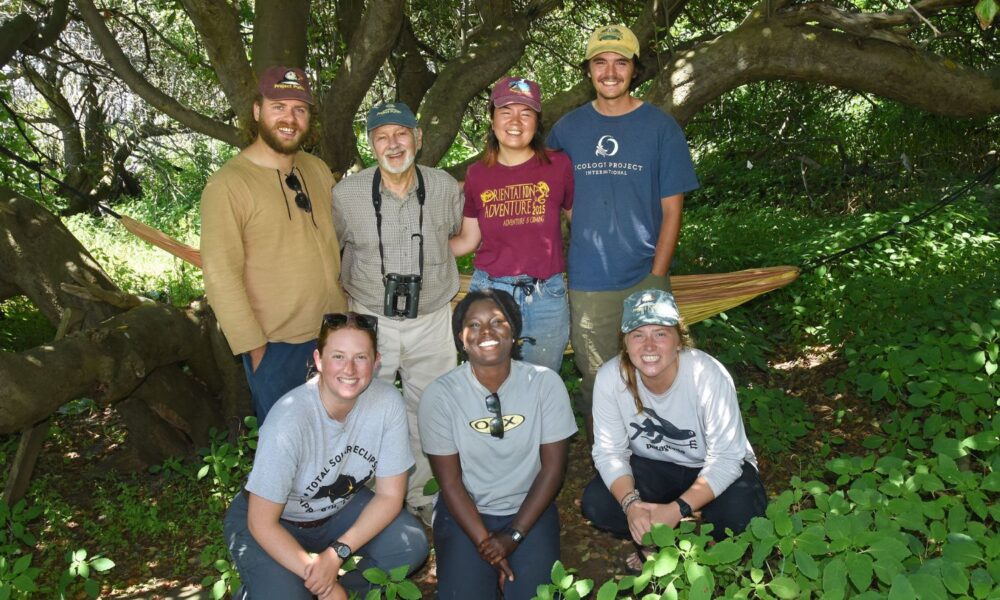
The sentiments were echoed 32 miles away in the Gulf of Maine out on Seal Island, another island where puffins were restored after a century’s absence. The crew there consisted of supervisor Coco Faber, 30, and assistants Amiel Hopkins, 19, Liv Ridley, 26, Reed Robinson, 19, and Nacho Gutierrez, 24.
Faber, in her ninth summer with the project, has seen some of the most volatile years of boom and bust for seabirds with the warming Gulf of Maine. “With climate change, the threats feel so amorphous and big, it’s hard to know where to go,” she said. “There are no more normal years. I now wonder every summer, what am I going to witness. When I [feel] down, I think of Steve and all his optimism, and how he threw spaghetti at the wall to bring these birds back.”
Ridley added, “They say one person can only do so much,” Ridley said, “But here, with [Kress’s] legacy you know you’re carrying on. You’re inspired to say I’m going to give my life to seabirds.”
Kress retired from the project in 2019, handing it over to Don Lyons, a tern researcher from Oregon State. Lyons said Kress left behind “community and continuity” that he could not find a comparison to.
“Steve is very focused on thanking people for their contributions,” Lyons, 59, said. “That includes a new researcher who lugged a boat up onto rocks or other seemingly menial tasks like data entry. It makes people feel valuable.”
So valuable that back on Stratton Island, Tiffany Christian, who lives the rest of the year in the Chicago area and is in her first summer on a Maine research island, said the magic of being surrounded by seabirds on an island was like being in “an ornate castle built in the sky.” She said the project’s legacy and the camaraderie “gives me a new awareness of what I want to do in the future.”
Kress himself said he did not intentionally set out to pass on a culture of such caring, but as it turns out, he looks at that culture as the “greatest hope” for seabirds. “Wherever I go, China, Ecuador, I see the same type of person,” he said. “There is this idea of healing the earth. I sure didn’t create that, but perhaps there’s something about this project that captured that.
“It helps that this project is such a conspicuous success that people are today surrounded by come-back birds, baby birds, all this life. I hope that future generations of seabird stewards continue this amazing story. You can’t avoid the feel-good part of it. I don’t need to say anything. The birds constantly remind the researchers that they are part of a miracle.”
Read more about Puffin Island and the efforts to save seabirds in Maine here and here.
